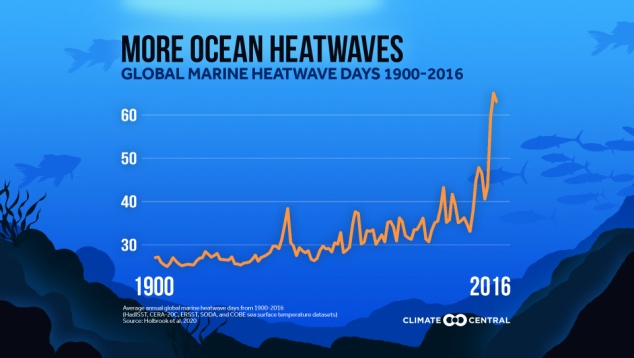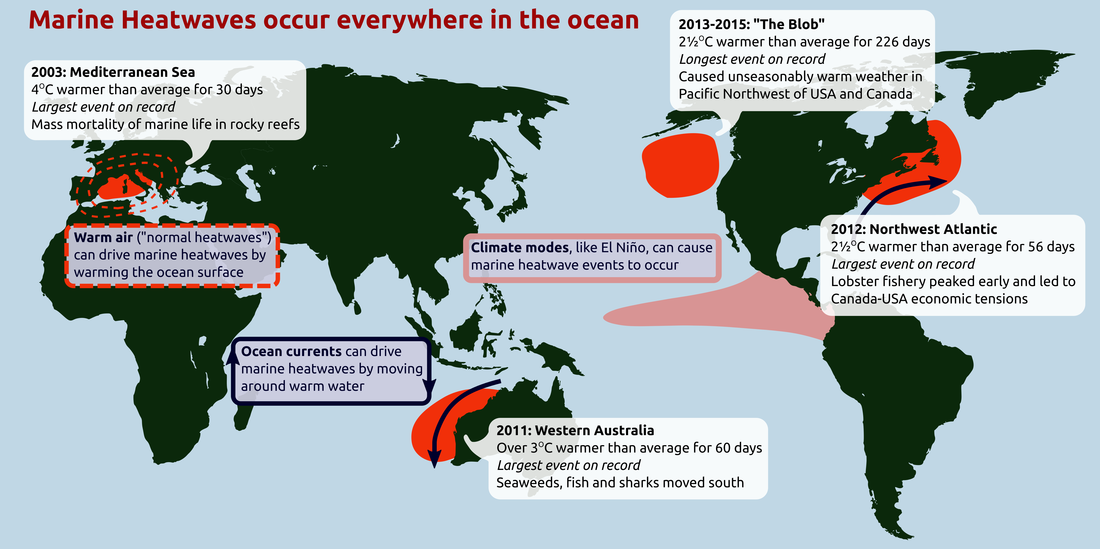Description

Disclaimer: Copyright infringement not intended.
Context
- Marine heat waves (MHW), which are periods of increased temperatures over seas and oceans, in the Indian Ocean region have increased significantly in the past few decades: study published in the journal JGR Oceans.
- The increase in marine heat waves was due to rapid warming in the Indian Ocean and strong El Nino events.
About
- A marine heat wave (MHW) is a short period of abnormally high temperatures in a sea or ocean.
- During an MHW, the average temperatures of the ocean surface (up to a depth of 300 feet) goes 5-7 degrees Celsius above normal.
- A marine heat wave is defined as when seawater temperatures exceed a seasonally-varying threshold for at least 5 consecutive days.
Causes
- Such heat waves are caused by an increase in the heat content of oceans, especially in the upper layers.
- Worldwide, they are one of the major results of human-induced global warming.
- Around 90 per cent of the warming caused by greenhouse gas emissions is absorbed by the oceans. The year 2021 broke all previous records for ocean heat.
- The most common drivers of marine heat waves include ocean currents which can build up areas of warm water and air-sea heat flux, or warming through the ocean surface from the atmosphere.
- Winds can enhance or suppress the warming in a marine heat wave, and climate models like El Niño can change the likelihood of events occurring in certain regions.
Impact
Ecosystem
- Marine heat waves affect ecosystem structure, by supporting certain species and suppressing others.
- For example, after the 2011 marine heat wave in Western Australia the fish communities had a much more “tropical” nature than previously and switched from kelp forests to seaweed turfs.
Habitat changes
- Marine heat waves can change the habitat ranges of certain species, such as the spiny sea urchin off southeastern Australia which has been expanding southward into Tasmania at the expense of kelp forests which it feeds upon.
- Rogue animals can also find their way well outside their normal range, following the warm waters of a marine heat wave, such as this tropical fish found off Tasmania during the 2015/16 marine heat wave.
Economy
- Marine heat waves can cause economic losses through impacts on fisheries and aquaculture.
- In 2011 in Western Australia, the marine heat wave impacted the abalone fishery in the north of the state and in 2015/16 the marine heat wave off southeastern Australia led to high levels of abalone mortality in Tasmania.
- That event also led to outbreaks of Pacific oyster mortality syndrome and also poor performance in Atlantic salmon aquaculture.
Biodiversity
- Biodiversity can be drastically affected by marine heat waves.
- In 2016, marine heat waves across northern Australia led to severe bleaching of the Great Barrier Reef and have been speculated to be linked to mangrove die-offs in the Gulf of Carpentaria.
Past Instances
- A marine heat wave spanning over 6.5 million square kilometers had affected the Pacific Ocean off the coast of the state of Oregon in the United States in September 2019.
- Other major marine heat wave events such as Great Barrier Reef 2002, Mediterranean 2003, Northwest Atlantic 2012, and Northeast Pacific 2013-2016.

Recent Findings pertaining to Indian Ocean
- In the Indian Ocean, the worst-affected were its western part and northern Bay of Bengal, according to the study.
- The number of MHWs in the West Indian ocean increased by around 1.5 events per decade between 1982 and 2018.
- The occurrences went up by around 0.5 events per decade in North Bay of Bengal in the same period.
- There were a total of 66 events in West Indian Ocean and 94 in North Bay of Bengal in the 36 years.
- The Intergovernmental Panel on Climate Change (IPCC) report on Global Warming of 1.5 °C is "virtually certain" that the global ocean has absorbed more than 90% of the excess heat in our climate systems, the rate of ocean warming has doubled, and MHW events have doubled in frequency since 1982.
- Impact: The marine heat waves in the Indian Ocean are also majorly impacting the southwest monsoon — the main rain-bearing system over the Indian subcontinent. The MHWs in the two worst-hit regions reduce monsoon rainfall over central India. Note: This is the first time a study has demonstrated a close link between marine heat waves and atmospheric circulation and rainfall.
|
Concern
The Intergovernmental Panel on Climate Change (IPCC) 5th assessment report projects that the global ocean will continue to warm well into the 21st century. The warming in the upper ocean is projected to be between 0.6°C and 2°C! We can therefore expect a future continuation, and possibly acceleration, of the historic warming-driven changes in marine heat waves.
|
Final Thoughts
- The frequency, intensity and area covered by the marine heat waves are increasing.
- We need to enhance our ocean observational arrays to monitor these events
- It is also imperative to update our weather models to skilfully predict the challenges presented by a warming world.
- By raising general awareness of these phenomena, and by improving our scientific understanding of their physical properties and ecological impacts, we can better predict future conditions and protect vulnerable marine habitats and resources.
https://www.downtoearth.org.in/news/climate-change/frequent-marine-heatwaves-in-indian-ocean-disrupt-india-s-monsoon-patterns-81379













